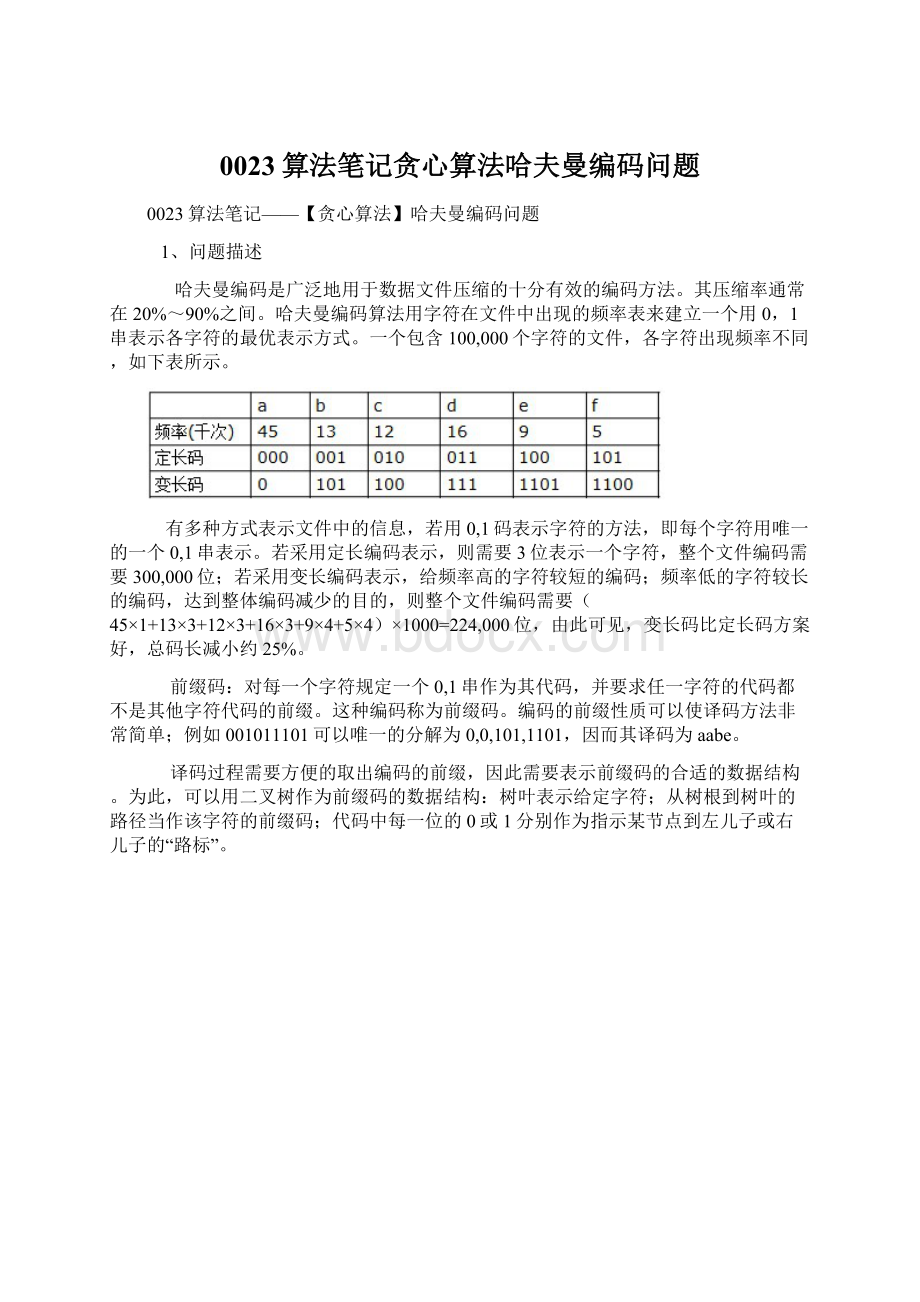0023算法笔记贪心算法哈夫曼编码问题.docx
《0023算法笔记贪心算法哈夫曼编码问题.docx》由会员分享,可在线阅读,更多相关《0023算法笔记贪心算法哈夫曼编码问题.docx(18页珍藏版)》请在冰豆网上搜索。

0023算法笔记贪心算法哈夫曼编码问题
0023算法笔记——【贪心算法】哈夫曼编码问题
1、问题描述
哈夫曼编码是广泛地用于数据文件压缩的十分有效的编码方法。
其压缩率通常在20%~90%之间。
哈夫曼编码算法用字符在文件中出现的频率表来建立一个用0,1串表示各字符的最优表示方式。
一个包含100,000个字符的文件,各字符出现频率不同,如下表所示。
有多种方式表示文件中的信息,若用0,1码表示字符的方法,即每个字符用唯一的一个0,1串表示。
若采用定长编码表示,则需要3位表示一个字符,整个文件编码需要300,000位;若采用变长编码表示,给频率高的字符较短的编码;频率低的字符较长的编码,达到整体编码减少的目的,则整个文件编码需要(45×1+13×3+12×3+16×3+9×4+5×4)×1000=224,000位,由此可见,变长码比定长码方案好,总码长减小约25%。
前缀码:
对每一个字符规定一个0,1串作为其代码,并要求任一字符的代码都不是其他字符代码的前缀。
这种编码称为前缀码。
编码的前缀性质可以使译码方法非常简单;例如001011101可以唯一的分解为0,0,101,1101,因而其译码为aabe。
译码过程需要方便的取出编码的前缀,因此需要表示前缀码的合适的数据结构。
为此,可以用二叉树作为前缀码的数据结构:
树叶表示给定字符;从树根到树叶的路径当作该字符的前缀码;代码中每一位的0或1分别作为指示某节点到左儿子或右儿子的“路标”。
从上图可以看出,表示最优前缀码的二叉树总是一棵完全二叉树,即树中任意节点都有2个儿子。
图a表示定长编码方案不是最优的,其编码的二叉树不是一棵完全二叉树。
在一般情况下,若C是编码字符集,表示其最优前缀码的二叉树中恰有|C|个叶子。
每个叶子对应于字符集中的一个字符,该二叉树有|C|-1个内部节点。
给定编码字符集C及频率分布f,即C中任一字符c以频率f(c)在数据文件中出现。
C的一个前缀码编码方案对应于一棵二叉树T。
字符c在树T中的深度记为dT(c)。
dT(c)也是字符c的前缀码长。
则平均码长定义为:
使平均码长达到最小的前缀码编码方案称为C的最优前缀码。
2、构造哈弗曼编码
哈夫曼提出构造最优前缀码的贪心算法,由此产生的编码方案称为哈夫曼编码。
其构造步骤如下:
(1)哈夫曼算法以自底向上的方式构造表示最优前缀码的二叉树T。
(2)算法以|C|个叶结点开始,执行|C|-1次的“合并”运算后产生最终所要求的树T。
(3)假设编码字符集中每一字符c的频率是f(c)。
以f为键值的优先队列Q用在贪心选择时有效地确定算法当前要合并的2棵具有最小频率的树。
一旦2棵具有最小频率的树合并后,产生一棵新的树,其频率为合并的2棵树的频率之和,并将新树插入优先队列Q。
经过n-1次的合并后,优先队列中只剩下一棵树,即所要求的树T。
构造过程如图所示:
具体代码实现如下:
(1)4d4.cpp,程序主文件
[cpp] viewplain copy
1.//4d4 贪心算法 哈夫曼算法
2.#include "stdafx.h"
3.#include "BinaryTree.h"
4.#include "MinHeap.h"
5.#include
6.using namespace std;
7.
8.const int N = 6;
9.
10.template class Huffman;
11.
12.template
13.BinaryTree HuffmanTree(Type f[],int n);
14.
15.template
16.class Huffman
17.{
18. friend BinaryTree HuffmanTree(Type[],int);
19. public:
20. operator Type() const
21. {
22. return weight;
23. }
24. //private:
25. BinaryTree tree;
26. Type weight;
27.};
28.
29.int main()
30.{
31. char c[] = {'0','a','b','c','d','e','f'};
32. int f[] = {0,45,13,12,16,9,5};//下标从1开始
33. BinaryTree t = HuffmanTree(f,N);
34.
35. cout<<"各字符出现的对应频率分别为:
"<36. for(int i=1; i<=N; i++)
37. {
38. cout<"<39. }
40. cout<41.
42. cout<<"生成二叉树的前序遍历结果为:
"<43. t.Pre_Order();
44. cout<45.
46. cout<<"生成二叉树的中序遍历结果为:
"<47. t.In_Order();
48. cout<49.
50. t.DestroyTree();
51. return 0;
52.}
53.
54.template
55.BinaryTree HuffmanTree(Type f[],int n)
56.{
57. //生成单节点树
58. Huffman *w = new Huffman[n+1];
59. BinaryTree z,zero;
60.
61. for(int i=1; i<=n; i++)
62. {
63. z.MakeTree(i,zero,zero);
64. w[i].weight = f[i];
65. w[i].tree = z;
66. }
67.
68. //建优先队列
69. MinHeap> Q(n);
70. for(int i=1; i<=n; i++) Q.Insert(w[i]);
71.
72. //反复合并最小频率树
73. Huffman x,y;
74. for(int i=1; i75. {
76. x = Q.RemoveMin();
77. y = Q.RemoveMin();
78. z.MakeTree(0,x.tree,y.tree);
79. x.weight += y.weight;
80. x.tree = z;
81. Q.Insert(x);
82. }
83.
84. x = Q.RemoveMin();
85.
86. delete[] w;
87.
88. return x.tree;
89.}
(2)BinaryTree.h二叉树实现
[cpp] viewplain copy
1.#include
2.using namespace std;
3.
4.template
5.struct BTNode
6.{
7. T data;
8. BTNode *lChild,*rChild;
9.
10. BTNode()
11. {
12. lChild=rChild=NULL;
13. }
14.
15. BTNode(const T &val,BTNode *Childl=NULL,BTNode *Childr=NULL)
16. {
17. data=val;
18. lChild=Childl;
19. rChild=Childr;
20. }
21.
22. BTNode* CopyTree()
23. {
24. BTNode *nl,*nr,*nn;
25.
26. if(&data==NULL)
27. return NULL;
28.
29. nl=lChild->CopyTree();
30. nr=rChild->CopyTree();
31.
32. nn=new BTNode(data,nl,nr);
33. return nn;
34. }
35.};
36.
37.
38.template
39.class BinaryTree
40.{
41. public:
42. BTNode *root;
43. BinaryTree();
44. ~BinaryTree();
45.
46. void Pre_Order();
47. void In_Order();
48. void Post_Order();
49.
50. int TreeHeight()const;
51. int TreeNodeCount()const;
52.
53. void DestroyTree();
54. void MakeTree(T pData,BinaryTree leftTree,BinaryTree rightTree);
55. void Change(BTNode *r);
56.
57. private:
58. void Destroy(BTNode *&r);
59. void PreOrder(BTNode *r);
60. void InOrder(BTNode *r);
61. void PostOrder(BTNode *r);
62.
63. int Height(const BTNode *r)const;
64. int NodeCount(const BTNode *r)const;
65.};
66.
67.template
68.BinaryTree:
:
BinaryTree()
69.{
70. root=NULL;
71.}
72.
73.template
74.BinaryTree:
:
~BinaryTree()
75.{
76.
77.}
78.
79.template
80.void BinaryTree:
:
Pre_Order()
81.{
82. PreOrder(root);
83.}
84.
85.template
86.void BinaryTree:
:
In_Order()
87.{
88. InOrder(root);
89.}
90.
91.template
92.void BinaryTree:
:
Post_Order()
93.{
94. PostOrder(root);
95.}
96.
97.template
98.int BinaryTree:
:
TreeHeight()const
99.{
100. return Height(root);
101.}
102.
103.template
104.int BinaryTree:
:
TreeNodeCount()const
105.{
106. return NodeCount(root);
107.}
108.
109.template
110.void BinaryTree:
:
DestroyTree()
111.{
112. Destroy(root);
113.}
114.
115.template
116.void BinaryTree:
:
PreOrder(BTNode *r)
117.{
118. if(r!
=NULL)
119. {
120. cout<data<<' ';
121. PreOrder(r->lChild);
122. PreOrder(r->rChild);
123. }
124.}
125.
126.template
127.void BinaryTree:
:
InOrder(BTNode *r)
128.{
129. if(r!
=NULL)
130. {
131. InOrder(r->lChild);
132. cout<data<<' ';
133. InOrder(r->rChild);
134. }
135.}
136.
137.template
138.void BinaryTree:
:
PostOrder(BTNode *r)
139.{
140. if(r!
=NULL)
141. {
142. PostOrder(r->lChild);
143. PostOrder(r->rChild);
144. cout<data<<' ';
145. }
146.}
147.
148.template
149.int BinaryTree:
:
NodeCount(const BTNode *r)const
150.{
151. if(r==NULL)
152. return 0;
153. else
154. return 1+NodeCount(r->lChild)+NodeCount(r->rChild);
155.}
156.
157.template
158.int BinaryTree:
:
Height(const BTNode *r)const
159.{
160. if(r==NULL)
161. return 0;
162. else
163. {
164. int lh,rh;
165. lh=Height(r->lChild);
166. rh=Height(r->rChild);
167. return 1+(lh>rh?
lh:
rh);
168. }
169.}
170.
171.template
172.void BinaryTree:
:
Destroy(BTNode *&r)
173.{
174. if(r!
=NULL)
175. {
176. Destroy(r->lChild);
177. Destroy(r->rChild);
178. delete r;
179. r=NULL;
180. }
181.}
182.
183.template
184.void BinaryTree:
:
Change(BTNode *r)//将二叉树bt所有结点的左右子树交换
185.{
186. BTNode *p;
187. if(r){
188. p=r->lChild;
189. r->lChild=r->rChild;
190. r->rChild=p; //左右子女交换
191. Change(r->lChild); //交换左子树上所有结点的左右子树
192. Change(r->rChild); //交换右子树上所有结点的左右子树
193. }
194.}
195.
196.template
197.void BinaryTree:
:
MakeTree(T pData,BinaryTree leftTree,BinaryTree rightTree)
198.{
199. root = new BTNode();
200. root->data = pData;
201. root->lChild = leftTree.root;
202. root->rChild = rightTree.root;
203.}
(3)MinHeap.h最小堆实现
[cpp] viewplain copy
1.#include
2.using namespace std;
3.template
4.class MinHeap
5.{
6. private:
7. T *heap; //元素数组,0号位置也储存元素
8. int CurrentSize; //目前元素个数
9. int MaxSize; //可容纳的最多元素个数
10.
11. void FilterDown(const int start,const int end); //自上往下调整,使关键字小的节点在上
12. void FilterUp(int start); //自下往上调整
13.
14. public:
15. MinHeap(int n=1000);
16. ~MinHeap();
17. bool Insert(const T &x); //插入元素
18.
19. T RemoveMin(); //删除最小元素
20. T GetMin(); //取最小元素
21.
22. bool IsEmpty() const;
23. bool IsFull() const;
24. void Clear();
25.};
26.
27.template
28.MinHeap:
:
MinHeap(int n)
29.{
30. MaxSize=n;
31. heap=new T[MaxSize];
32. CurrentSize=0;
33.}
34.
35.template
36.MinHeap:
:
~MinHeap()
37.{
38. delete []heap;
39.}
40.
41.template
42.void MinHeap:
:
FilterUp(int start) //自下往上调整
43.{
44. int j=start,i=(j-1)/2; //i指向j的双亲节点
45. T temp=heap[j];
46.
47. while(j>0)
48. {
49. if(heap[i]<=temp)
50. break;
51. else
52. {
53.